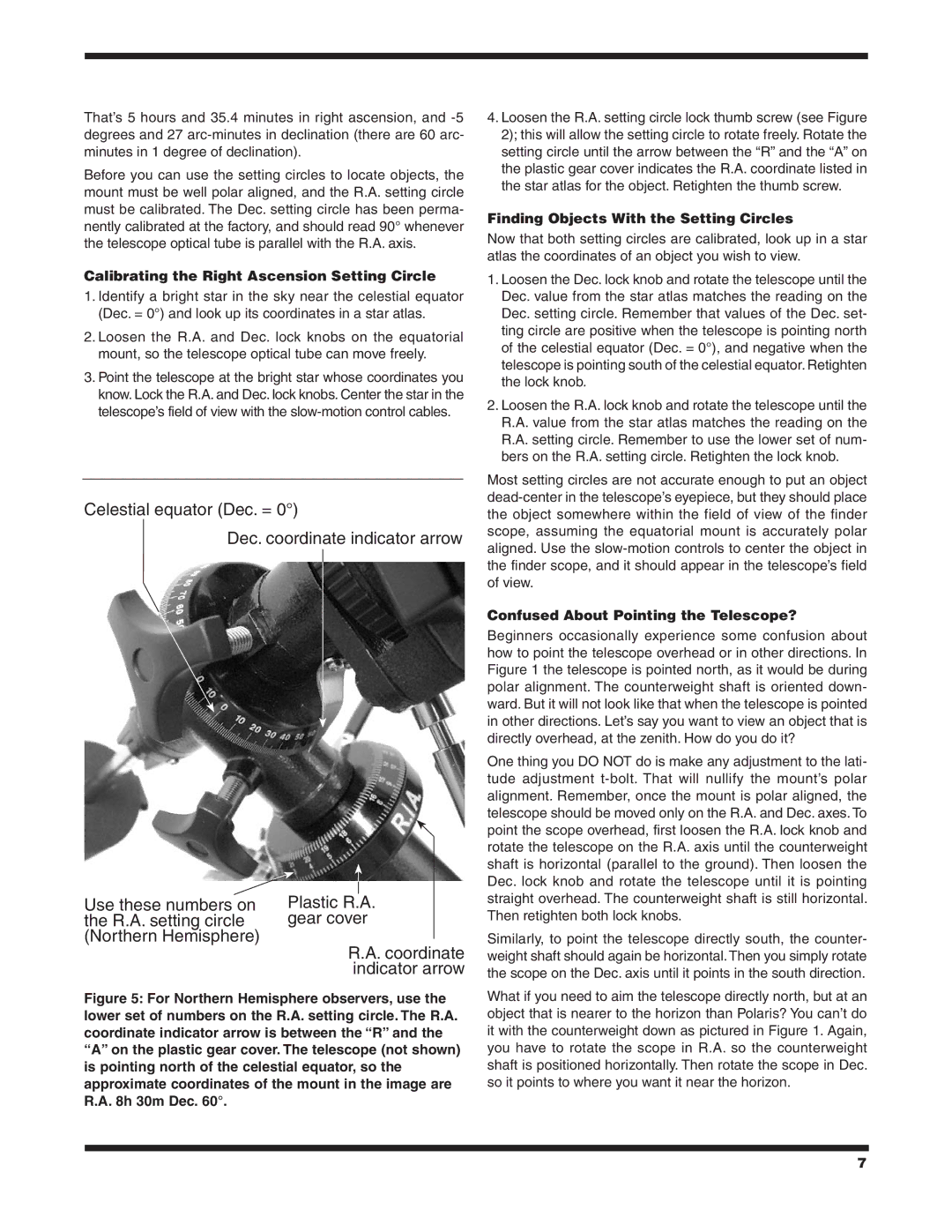
That’s 5 hours and 35.4 minutes in right ascension, and
Before you can use the setting circles to locate objects, the mount must be well polar aligned, and the R.A. setting circle must be calibrated. The Dec. setting circle has been perma- nently calibrated at the factory, and should read 90° whenever the telescope optical tube is parallel with the R.A. axis.
Calibrating the Right Ascension Setting Circle
1.Identify a bright star in the sky near the celestial equator (Dec. = 0°) and look up its coordinates in a star atlas.
2.Loosen the R.A. and Dec. lock knobs on the equatorial mount, so the telescope optical tube can move freely.
3.Point the telescope at the bright star whose coordinates you know. Lock the R.A. and Dec. lock knobs. Center the star in the telescope’s field of view with the
Celestial equator (Dec. = 0°)
Dec. coordinate indicator arrow
|
|
|
Use these numbers on | Plastic R.A. | |
the R.A. setting circle | gear cover | |
(Northern Hemisphere) | R.A. coordinate | |
| ||
| indicator arrow | |
Figure 5: For Northern Hemisphere observers, use the lower set of numbers on the R.A. setting circle. The R.A. coordinate indicator arrow is between the “R” and the “A” on the plastic gear cover. The telescope (not shown) is pointing north of the celestial equator, so the approximate coordinates of the mount in the image are R.A. 8h 30m Dec. 60°.
4.Loosen the R.A. setting circle lock thumb screw (see Figure 2); this will allow the setting circle to rotate freely. Rotate the setting circle until the arrow between the “R” and the “A” on the plastic gear cover indicates the R.A. coordinate listed in the star atlas for the object. Retighten the thumb screw.
Finding Objects With the Setting Circles
Now that both setting circles are calibrated, look up in a star atlas the coordinates of an object you wish to view.
1.Loosen the Dec. lock knob and rotate the telescope until the Dec. value from the star atlas matches the reading on the Dec. setting circle. Remember that values of the Dec. set- ting circle are positive when the telescope is pointing north of the celestial equator (Dec. = 0°), and negative when the telescope is pointing south of the celestial equator. Retighten the lock knob.
2.Loosen the R.A. lock knob and rotate the telescope until the R.A. value from the star atlas matches the reading on the R.A. setting circle. Remember to use the lower set of num- bers on the R.A. setting circle. Retighten the lock knob.
Most setting circles are not accurate enough to put an object
Confused About Pointing the Telescope?
Beginners occasionally experience some confusion about how to point the telescope overhead or in other directions. In Figure 1 the telescope is pointed north, as it would be during polar alignment. The counterweight shaft is oriented down- ward. But it will not look like that when the telescope is pointed in other directions. Let’s say you want to view an object that is directly overhead, at the zenith. How do you do it?
One thing you DO NOT do is make any adjustment to the lati- tude adjustment
Similarly, to point the telescope directly south, the counter- weight shaft should again be horizontal. Then you simply rotate the scope on the Dec. axis until it points in the south direction.
What if you need to aim the telescope directly north, but at an object that is nearer to the horizon than Polaris? You can’t do it with the counterweight down as pictured in Figure 1. Again, you have to rotate the scope in R.A. so the counterweight shaft is positioned horizontally. Then rotate the scope in Dec. so it points to where you want it near the horizon.
7
